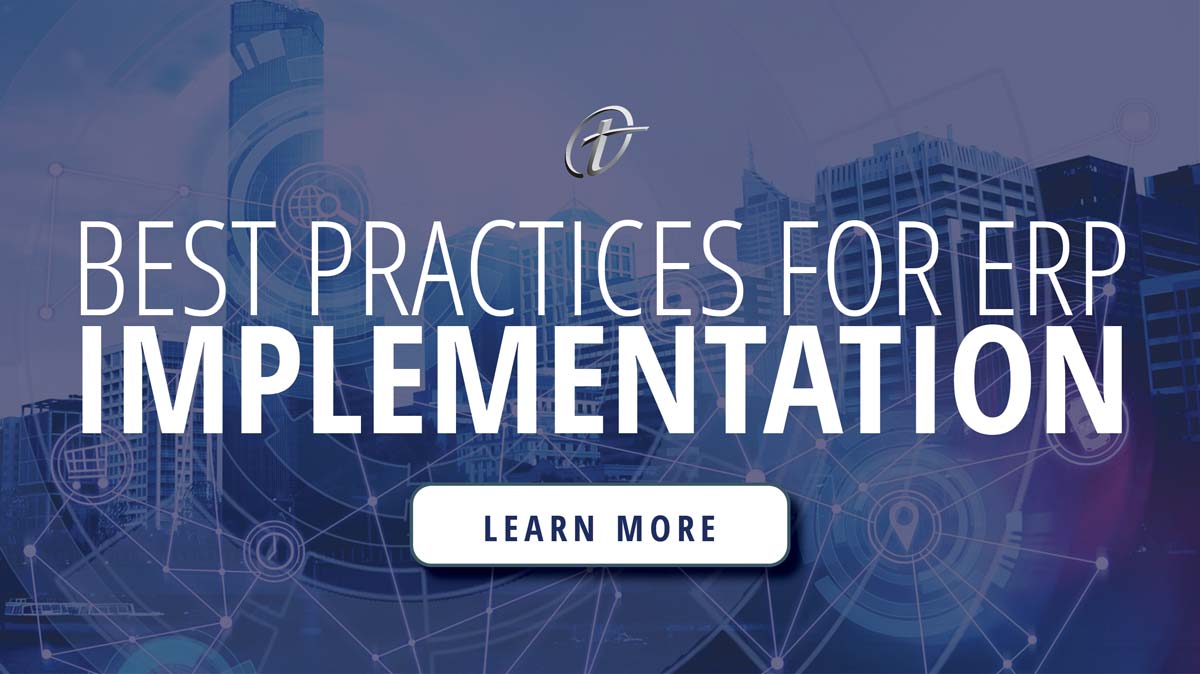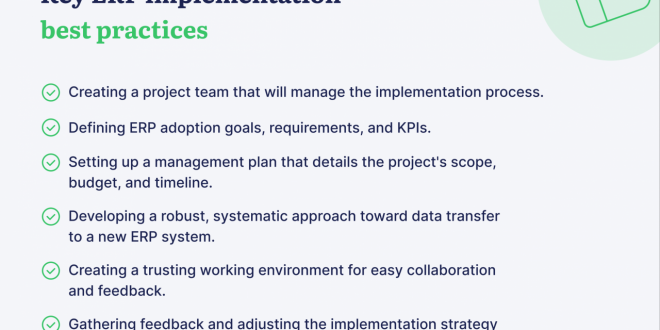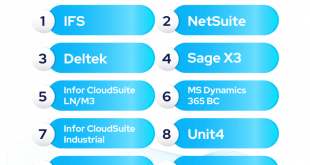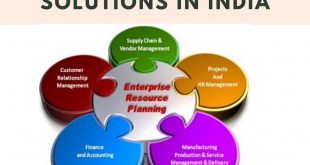ERP best practices offer a comprehensive framework for organizations seeking to optimize their enterprise resource planning (ERP) systems. By adhering to these guidelines, businesses can unlock the full potential of their ERP solutions, streamline operations, enhance decision-making, and achieve greater efficiency.
This in-depth guide delves into the core principles, implementation strategies, integration techniques, security measures, reporting capabilities, and analytical applications of ERP best practices. It provides real-world examples, practical advice, and expert insights to empower organizations in their pursuit of ERP excellence.
ERP Best Practices

ERP best practices refer to the established guidelines and methodologies that organizations follow to ensure successful ERP implementations and maximize the benefits of ERP systems.
These best practices encompass various aspects of ERP implementation, including:
- Planning and preparation
- Process reengineering
- Data migration
- Change management
- User adoption
Core Principles of ERP Best Practices
The core principles underlying ERP best practices include:
- Integration:ERP systems should seamlessly integrate all business processes and functions.
- Data accuracy:Data should be accurate, consistent, and timely.
- Process efficiency:ERP systems should streamline and automate processes to improve efficiency.
- User adoption:Users should be actively involved in the implementation process and trained to use the system effectively.
- Continuous improvement:Organizations should continuously monitor and evaluate their ERP systems and make improvements as needed.
Examples of Successful ERP Implementations
Numerous organizations have successfully implemented ERP systems following best practices. Here are a few examples:
- General Electric:GE successfully implemented an ERP system to improve its supply chain management and reduce costs.
- Nike:Nike implemented an ERP system to streamline its global operations and enhance collaboration.
- Wal-Mart:Wal-Mart implemented an ERP system to improve its inventory management and customer service.
ERP Implementation
ERP implementation is a complex process that requires careful planning and execution. The key steps involved in ERP implementation include:
- Planning: This involves defining the project scope, identifying the project team, and developing a project plan.
- Data preparation: This involves gathering and cleaning the data that will be used in the ERP system.
- Configuration: This involves setting up the ERP system to meet the specific needs of the organization.
- Testing: This involves testing the ERP system to ensure that it is working properly.
- Deployment: This involves rolling out the ERP system to the end users.
- Support: This involves providing ongoing support to the end users after the ERP system has been deployed.
Common Challenges, Erp best practices
There are a number of common challenges that organizations face during ERP implementation. These challenges include:
- Lack of planning: This can lead to delays, cost overruns, and system failures.
- Data quality issues: This can lead to inaccurate reporting and poor decision-making.
- Resistance to change: This can make it difficult to get employees to adopt the new ERP system.
- Lack of communication: This can lead to misunderstandings and delays.
- Lack of training: This can lead to errors and inefficiencies.
Overcoming Challenges
There are a number of ways to overcome the challenges of ERP implementation. These include:
- Developing a comprehensive project plan: This will help to ensure that the project is completed on time and within budget.
- Investing in data preparation: This will help to ensure that the data in the ERP system is accurate and complete.
- Communicating effectively with stakeholders: This will help to keep everyone informed about the project and to address any concerns.
- Providing adequate training: This will help employees to learn how to use the new ERP system and to maximize its benefits.
- Establishing a support system: This will help employees to get the help they need after the ERP system has been deployed.
ERP Integration
ERP integration is the process of connecting different software applications and systems within an organization to create a unified and streamlined IT environment. This allows for the seamless flow of data between different systems, eliminating the need for manual data entry and reducing the risk of errors.
There are several methods for integrating ERP systems with other systems, including:
Data Integration
Data integration involves establishing a connection between the ERP system and other systems, such as CRM, SCM, and HR systems. This allows for the exchange of data between the systems, ensuring that all systems have access to the most up-to-date information.
Functional Integration
Functional integration involves integrating the functionality of different systems into the ERP system. This allows users to access and use the functionality of other systems from within the ERP system, eliminating the need to switch between multiple systems.
Process Integration
Process integration involves integrating the business processes of different systems into the ERP system. This allows for the automation of business processes across multiple systems, reducing the need for manual intervention and improving efficiency.
ERP Cloud

ERP cloud solutions are hosted on remote servers and accessed over the internet. This eliminates the need for businesses to purchase and maintain their own hardware and software, which can save significant costs.
ERP cloud solutions also offer a number of other benefits, including:
- Scalability:ERP cloud solutions can be easily scaled up or down to meet the changing needs of businesses.
- Flexibility:ERP cloud solutions can be accessed from anywhere with an internet connection, which gives businesses the flexibility to work from anywhere.
- Security:ERP cloud solutions are hosted in secure data centers and are managed by experienced professionals, which helps to protect businesses from data breaches.
Challenges of ERP Cloud Implementations
While ERP cloud solutions offer a number of benefits, there are also some challenges to consider before implementing one.
- Cost:ERP cloud solutions can be more expensive than on-premise solutions, especially for businesses with large amounts of data.
- Integration:ERP cloud solutions can be difficult to integrate with other business systems, which can lead to data silos and inefficiencies.
- Security:While ERP cloud solutions are generally secure, businesses need to be aware of the risks involved and take steps to protect their data.
ERP Vendors: Erp Best Practices
Selecting the right ERP vendor is crucial for the success of your ERP implementation. Here’s a comparison of leading ERP vendors and factors to consider when making your choice:
Vendor Comparison
- SAP: Known for its comprehensive suite of ERP solutions, strong industry expertise, and global reach.
- Oracle: Offers a wide range of ERP solutions, including cloud-based and on-premise options, with a focus on enterprise-level businesses.
- Microsoft: Provides ERP solutions tailored for small and medium-sized businesses, with a focus on ease of use and integration with Microsoft products.
- Infor: Specializes in industry-specific ERP solutions, catering to specific needs of various industries.
- NetSuite: A cloud-based ERP solution provider, offering a comprehensive suite of business applications for growing businesses.
Factors to Consider
When selecting an ERP vendor, consider the following factors:
- Industry expertise: Choose a vendor that has experience and expertise in your specific industry.
- Functionality: Ensure that the ERP solution meets your current and future business requirements.
- Scalability: Consider the size of your business and potential for growth when selecting an ERP vendor.
- Cost: Determine the total cost of ownership, including implementation, maintenance, and ongoing support.
- Support: Evaluate the vendor’s support offerings, including availability, responsiveness, and expertise.
- References: Ask for references from other businesses that have implemented the vendor’s ERP solution.
Conclusion
In conclusion, ERP best practices serve as an invaluable roadmap for organizations striving to harness the transformative power of ERP systems. By embracing these principles and leveraging the latest technologies, businesses can unlock unprecedented levels of operational efficiency, data-driven decision-making, and competitive advantage.
Originally posted 2024-05-20 13:12:26.
 Bussines News Daily
Bussines News Daily



